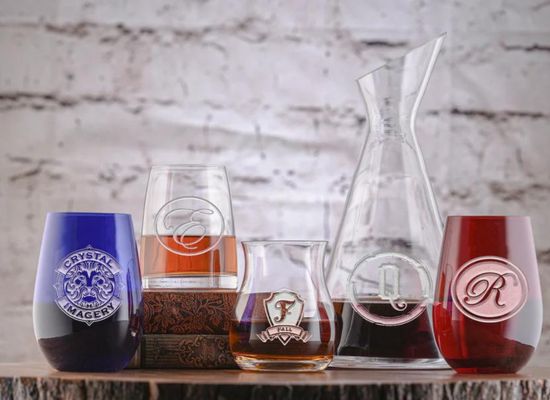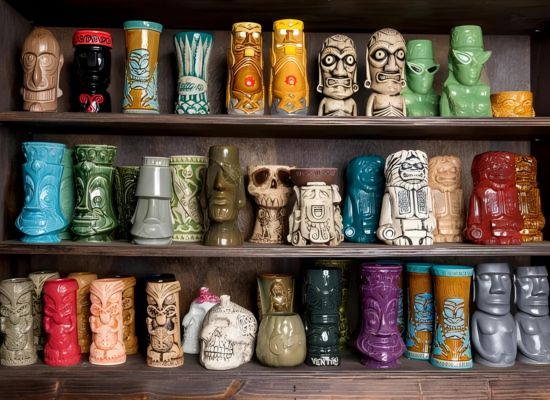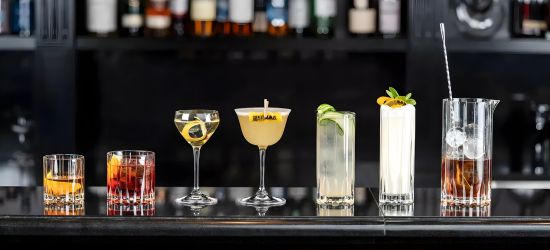Educating Bartenders Worldwide.
By Beverage Trade Network

The world of bartending and mixology is an ever-evolving landscape where tradition always goes along with innovation. Among the essential tools of the trade, bar glasses stand out as functional items and symbols of the artistry involved in creating the perfect drink. Over the years, glassware design has undergone significant transformations, influenced by changes in consumer preferences, technological advancements, and the creative visions of designers and mixologists. The evolution of bar glasses reflects broader trends in the hospitality industry, including a growing emphasis on sustainability, the desire for unique and personalized experiences, and the integration of cutting-edge technology. This article delves into the fascinating journey of bar glass design, exploring key trends and innovations that have shaped the modern cocktail experience.
The history of bar glasses dates back centuries, with each era contributing to the development of the diverse glassware we use today. In ancient times, beverages were consumed from simple clay or metal vessels. It wasn't until the Renaissance that glassblowing techniques advanced, allowing for the creation of more sophisticated glassware. The 18th and 19th centuries saw the rise of specialized glass shapes designed for specific types of drinks, reflecting the growing appreciation for the nuances of different beverages.

Source: Ashmolean Museum
The early 20th century, often called the Golden Age of Cocktails, marked a significant period in the evolution of bar glasses. This era saw the standardization of many classic glass shapes still in use today, such as the martini glass, coupe, and highball. Each glass was meticulously designed to enhance the drinking experience of specific cocktails. For instance, the wide bowl of the coupe allowed for better aeration and aroma release, while the narrow shape of the highball glass helped retain the carbonation in fizzy drinks.
As the craft cocktail movement gained momentum in the late 20th and early 21st centuries, bartenders and designers began to push the boundaries of glassware design. Modern innovations in bar glasses can be categorized into several key trends:
Customization and Personalization: Today’s consumers seek unique and personalized experiences, and this demand extends to the glassware used in bars and restaurants. Customization options, such as monogramming, etching, and bespoke designs, have become increasingly popular. Bars can now commission custom glassware that reflects their brand identity or enhances the theme of their cocktail menu. This trend not only adds a personal touch but also creates memorable experiences for consumers.
Sustainable and Eco-Friendly Glassware: Sustainability has become a major focus across all industries, including hospitality. The glassware industry has responded with eco-friendly options made from recycled materials or designed to minimize environmental impact. Innovations such as biodegradable drinking straws, reusable metal and bamboo stirrers, and glasses made from upcycled glass bottles are becoming more common. These sustainable choices appeal to environmentally conscious consumers and demonstrate a bar’s commitment to sustainability.

Source: Crystal Imagery
Advanced Materials and Technologies: Advancements in materials science have led to the development of glassware that is more durable and functional. For example, lead-free crystal glass offers the clarity and brilliance of traditional crystal without the associated health risks. Additionally, innovations such as double-walled glassware provide insulation, keeping drinks at the desired temperature for longer periods. Some modern glass designs also incorporate technology, such as embedded LED lights that illuminate the drink from within, creating a visually stunning effect.
Ergonomics and User Experience: Designers are increasingly focusing on the ergonomics of glassware, ensuring that each piece is comfortable to hold and use. This consideration extends to the weight, balance, and grip of the glass. Innovations such as textured surfaces or strategically placed indentations enhance the user experience by providing a more secure and enjoyable grip. These ergonomic designs are particularly important in high-volume settings where bartenders and patrons handle glasses frequently.

Source: The Orange County Register
The rise of mixology has led to the creation of specialty glassware designed for innovative cocktails. These glasses are often unconventional in shape and material, reflecting the creativity of modern mixologists.
Tiki Mugs and Novelty Glassware: Tiki culture has experienced a resurgence, bringing with it a demand for tiki mugs and novelty glassware. These whimsical vessels, often adorned with colorful and intricate designs, add an element of fun and escapism to the cocktail experience. They are typically used for tropical and rum-based drinks, such as the Mai Tai and Zombie, enhancing the overall theme and presentation. Notable brands such as Tiki Farm and Munktiki are renowned for their high-quality, artistically designed tiki mugs, which are sought after by both professional mixologists and home enthusiasts.
Molecular Mixology Glassware: Molecular mixology, which involves the use of scientific techniques to create unique cocktails, has spurred the development of specialized glassware. This includes items such as test tubes, beakers, and laboratory-style glassware that highlight the experimental nature of these drinks. Additionally, glasses designed for specific techniques, such as smoking or foaming, allow mixologists to push the boundaries of traditional cocktail-making. Brands like Cocktail Kingdom and Polyscience offer a range of molecular mixology glassware and equipment, providing the tools needed to craft innovative and visually striking cocktails.
Cultural and regional trends have a significant impact on glassware design. Different parts of the world have their traditions and preferences when it comes to drinking vessels. For example, Japanese glassware, known for its precision and artistry, has gained international acclaim. Traditional sake cups and glasses, made from materials such as porcelain, wood, and glass, reflect the meticulous attention to detail characteristic of Japanese craftsmanship. Modern Japanese glassware often incorporates minimalist design principles, emphasizing simplicity and elegance. Europe has a rich history of glassmaking, with countries like Italy, France, and Germany producing some of the finest crystal and glassware. Brands such as Riedel and Baccarat are renowned for their high-quality, handcrafted pieces. European glassware often combines traditional techniques with contemporary design, resulting in timeless and sophisticated pieces.

Source: Riedel
The integration of technology into glassware is an exciting frontier in the evolution of bar glasses. Smart glasses, equipped with sensors and connectivity features, offer new possibilities for enhancing the drinking experience.
Temperature-Sensitive Glasses: Some smart glasses are equipped with temperature-sensitive materials that change color based on the temperature of the drink. This not only adds a visual element but also helps ensure that the cocktail is served at the optimal temperature.
Augmented Reality Glasses: AR glasses can provide interactive experiences for the guests. By scanning a QR code on the glass, users can access digital content such as cocktail recipes, pairing suggestions, or the story behind the drink. This technology can create a more engaging and informative experience for guests.
The evolution of bar glasses is a testament to the dynamic nature of the hospitality industry. From the classic designs of the early 20th century to the innovative and personalized options available today, glassware has continuously adapted to meet the changing needs and preferences of consumers. As bartenders and mixologists strive to create memorable experiences, the role of glassware in enhancing presentation and flavor cannot be overstated. Looking ahead, the future of bar glass design promises to be as exciting and diverse as the cocktails they hold. By embracing new trends and innovations, bars can elevate their service and delight consumers with every pour, sip, and clink of the glass.
Header Image Source: Biyo